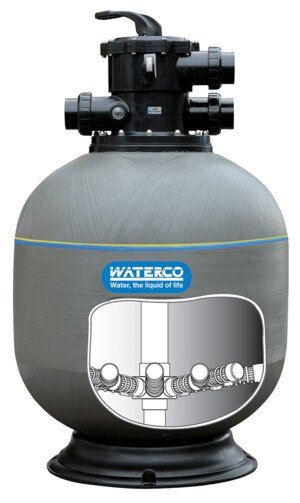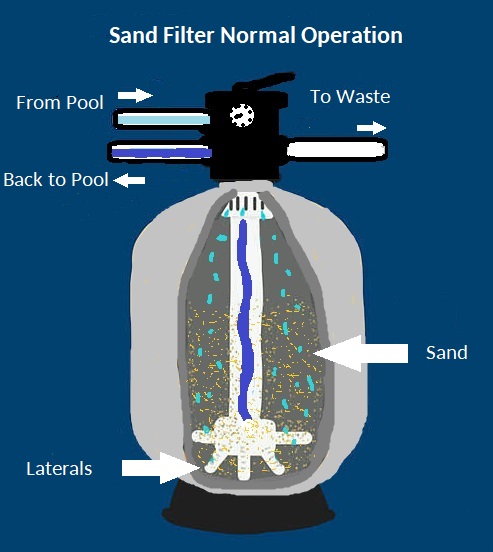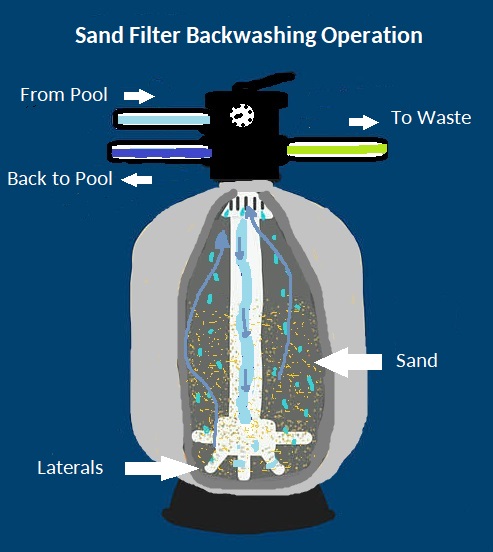
What is a pool sand filter?
A sand filter is a sand-filled tank connected to your pool's filtration system. When the water flows through the tank, the sand traps particles and trash that would otherwise return to the pool. As a result, the water is cleaner and clearer.
Although glass or zeolite can be used, most sand filters use #20 sand or mesh crystal silica #20. Typically constructed of stainless steel, fibreglass, or plastic, the sand filter housing is strong enough to resist the high pressure needed to operate the filtration system.
How does a pool sand filter work?
A pool sand filter can be made of various materials such as sand, diatomaceous earth, and other types of media. The pool sand filter works by passing water through a series of filters that trap particles larger than 2 microns in size.
The pool sand filter is typically installed at the bottom of the swimming pool. The water enters at one end and travels through the filtering material before exiting at the other end.
The first stage of filtration removes any large debris, such as leaves or twigs, that might have fallen into the pool from above. These large items are often caught by an automatic leaf net or safety cover that hangs over the top edge of your swimming pool.
How long does a pool sand filter last?
Ideally, you should replace your sand filter every three to five years. If the pool stays clear and the filter runs constantly, it won't wear down as quickly. The jagged edges of the sand soften or "round off" as it ages.
When this happens, the sand filter can no longer trap debris particles, and dirt can pass through the sand fliter and back into the pool. This leaves everything feeling murky or looking generally unpleasant.


Do you need chlorine with a sand filter?
With sand filters, chlorine is added because the sand serves to filter the pool water, whereas chlorine is used for sanitization.
Artificial chemicals like DE, sand, and cartridges can't replace chlorine when it comes to pool maintenance.
Though they work in different ways, various swimming pool artificial chemicals do offer a variety of benefits when it comes to water quality. Therefore, both are needed.
Backwashing Your Sand Filters
Sand filters need hands-on work even though they are easier to maintain in comparison. Let's examine what that entails.
Cleaning of Sand Filters
When you backwash and rinse the sand filter, your sand will be cleaned. Although sand filter sand can last five to seven years, you will probably need to replace it roughly every three years. Because the sand tends to cause the waste in the tank to coagulate, Baquacil users might discover that they need to change it every year.
Pro tip: You can soak your sand in a filter cleaner to dissolve clumps in your sand.
Sand Filter vs. Cartridge Filter: Which to Choose?
Sand filters may contain up to 250 pounds of specialty filter sand. Water is clean when it returns to the pool after passing through the sand, which traps dirt and other microscopic particles.
Sand filters need filter media replacements only every five to seven years, are easy to maintain, and are initially less expensive than their cartridge counterparts (depending on usage). An installed pressure gauge is present in every sand filter.
The owner will know it is time to wipe out the sand residue when the internal pressure of the filter has increased by 10 psi since the last cleaning. They can easily do this on their own.
Depending on usage, replacement should take place every three to four years. At least twice a year, but possibly more frequently, the filter must be opened and the cartridges completely cleaned.
This depends on usage and environmental circumstances. The cost of the cartridge elements is more than the cost of the initial filter purchase. In contrast to its sand counterparts, the cartridge material itself filters out tiny particles.
In a Nutshell
We hope this has helped you decide whether or not a sand filter is a good choice for your pool.
Generally, you will need a pool filter that can handle regular use and lasts the longest if you swim frequently. A sand filter is preferable because it requires less frequent replacement. It is also a cost-effective option for those who wish to save money.
Before making a decision, you should investigate the many types of filters to determine which one is optimal. Last but not least, it is also important to choose a filter that is compatible with the size of your pool.
As a leading swimming pool equipment supplier in Malaysia, we offer reliable solutions including pool filter systems or pool filtration systems, swimming pool equipment and accessories, and more. Feel free to get in touch with us to know more!